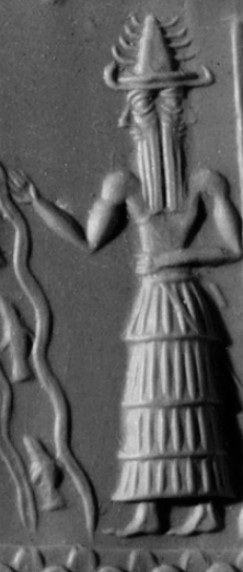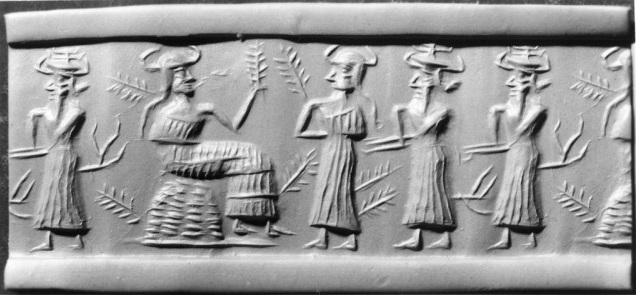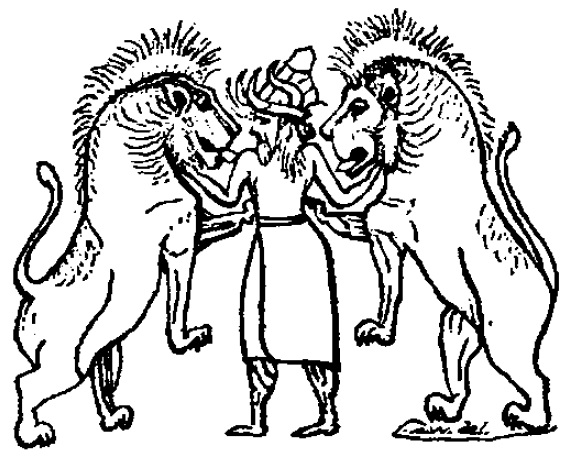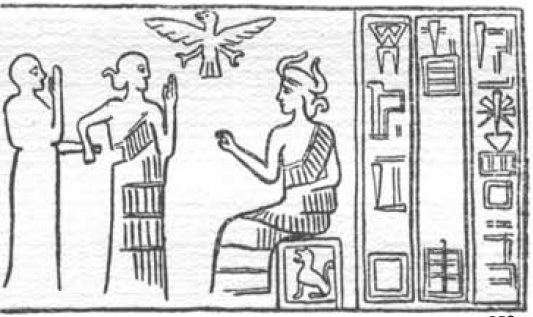
| VAJRA AND HORN HAT 12. Vajra Hat and Horn Hat:
1. Vajra Hat :
Akkadian cylinder seal dating to c. 2300 BC, depicting the deities Inanna, Utu, Enki, and Isimud
Deitie Isimud The Horned Hat according to me represents the "The Rowan Wood" and is Gothic Hat.
2. Horn Hat :
According to Lieutenant Colonel Laurence Austine Waddell :
The Phoenician Origin of Britons, Scots, & Anglo-Saxons (1924 - 1st. edition) :
The Horned Hat represents Goat.
Ninhursag Damgalnuna, Ninmah
Ninshubur
The Goat was the especially sacred animal of Indara, as recorded
in the Sumerian and Vedic texts, some of which are cited in the
heading; and Indara himself was, as therein cited, called by the
Sumerians "The He-Goat"; and Thor and his Goths are also
called "He-Goats" in the Gothic Eddas, wherein Thor is
called "Sig-Father," the identical name by which Bel also
is called.' i.e., by the Sumerian
Thus we find that the antagonism of the Goat (or "Unicorn") to the Lion (or Wolf or Dragon) is figured freely on Sumerian and Hitto-Phoenician seals from the earliest period, and also on Early Briton monuments and coins (see Figs. 59, 60), and that Indara himself is sometimes represented as a Goat or Deer (Dara) as the slayer or tamer of the demonist Lion, as is recorded also in the Vedic hymn which says : "Indra for the Goat [Goths] did to death the Lion".
Yet so little is our modern heraldry aware of the facts of origin, meaning and function of the "Unicorn" that it now represents that invincible Aryan totem of the Sun Cross-and of la or Jove and Thor and of Heaven, and of our ancestral Aryan originators of the World's Civilization-in the form of a one-horned horse, but significantly bearded like a Goat and bound in chains and set alongside of its vanquished foe of Civilization, which is supposed to have been its victor-the ravening Lion totem of the demonist Chaldee aborigines! Whereas in the old Hittite seals, it is the Lion which wears the collar and chain (see Fig. 59L.), whilst the Unicorn or Goat is the victor through Indara and his archangel.
The Goat, "the swift-footed one of the mountains of sunrise" is represented by the Sumerians as the Sun itself and a form of the Sun-god, though less frequently so than is the winged Sun or Sun-Hawk or Phoenix-the horse only appearing in the very latest period. In the Vedic hymns also, the Sun is sometimes called "the Goat," with the epithet of "The One Step," presumably from its ability to traverse the heavens to the supplicant in "one step" :-
"The Ruddy Sun . . . the One-Step Goat,
This "One Step Goat" in the Vedas is in especial conflict and contact with the Dragon of the Deep, just as we have seen was the Resurrecting Sun, the vanquisher of the Serpent-Dragon of the Deep and Death.
Rig Ved Mandala 7 Sukta 18 Mantra 17 :
In this capacity and in its struggle with the Lion or Wolf of Death, and as the rebus for "Goth" the Goat is freely represented on Hitto-Sumerian seals and on Phoenician and Greco-Phoenician coins, in association with the Sun Cross and the protecting Archangel Tas; see Fig. 59 and also later. And significantly it is similarly figured on Early Briton prehistoric monuments, pre-Christian Crosses, and Ancient Briton coins, and also in association with the Sun Cross, and often the protecting Archangel Tas or Tasc, see Fig. 60, and further examples later.
This picture of a "Goat" (in Old English Goot and Gote, Eddic Gothic Geit, Anglo-S. Gat and Scots Gait) in these scenes appears clearly to be used as a rebus picture-sign for "Goth" (properly Got or Goti ) or Getce, Sumerian Guti, Kud or Khat; just as the battle-axe picture-sign was used for their tribal title of "Khat-ti" or "Hitt-ite," The hieroglyphic practice of using rebus pictures for proper names continued popular in Greco-Phoenician and Greek coins in Asia Minor down to the Roman period.
This now explains also the references to the sacred Goat and Indra in the Vedic hymns. e.g., "The lively Goat goeth straightway bleating to the place dear to Indra. We now discover that the Sumerians and Hitto-Phoenicians or Early Goths called themselves, or their leading clans, by the names of "Goat," or by names which were more or less identical in sound with their name for Goat, and so made it easy for the picture of the Goat to represent rebuswise their title of "Goth".
This sacred character of the Goat as the totem animal of the Sumerians and Goths, and the source of the legend of the Unicorn, in its victory over the Lion, and as the hallowed animal of Indara or Andrew, now explains the fact of the Goat being still the mascot of the Welsh Cyrnri, and also the frequency of St. Andrew's Cross in the pre-Christian and early Christian monuments in Wales," and in parts of England. And the figures of the Goat in association with St. Andrew's Cross and other solar symbols on the Early Briton coins, and especially in the tin coins of Cornwall (and sometimes with the name Inara and "Ando") and in forms identical with those existing on Hitto-Phoenician sacred seals and Phcenician coins, affords still further conclusive evidence of the former widespread prevalence of the cult of Indara or "Andrew" in Early Britain, and of the Barat Catti Phoenician origin of the Britons and Scots.
FIG. 59. : Goats (and Deer) as "Goths" of Indara protected by Cross and Archangel Tas (Tashub Mikal) against Lion and Wolves on Hitto-Surmerian, Phoenician and Kassi Seals. (After Ward, etc.)
FIG. 60. : Ancient Briton Goats (and Deer) as "Goths" of Indara protected by Cross and Archangel Tascia (or Michael) against Lion and Wolves. According to Lieutenant Colonel Laurence Austine Waddell :
The Makers of Civilization in Race and History :
FIG. A. : Portrait (? contemporary) of First Aryan or Sumerian King Dar (Thor or St George of Cappadocia) taming (or civilizing) the Lion totem tribes, from ivory handle of stone-dagger, c. 3380 B.C. Note : His Gothic horned hat and dress.
FIG. 6o. : Eve enthroned as queen of the Goths. From Sumer seal, c. 2400 B.C. (After ward) Note : Her horned hat, Lion throne, and Sun-Hawk or Eagle emblems.
No 9 as per Circle Marks represents Goat and Indra :
000 000 000 = 9 or 90 (Ilim)
"He-Goat." God Elim (Bel, "En-Sakh" or "En-Lil" or Dara ?) [9 was number of Prometheus].
9 is the number of Indra. |
_-_EnKi_(Sumerian).jpg)







